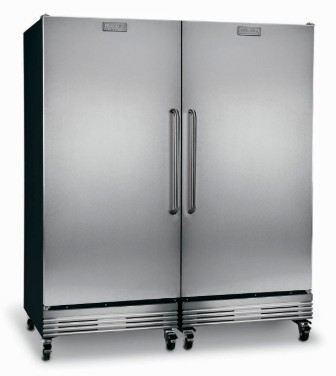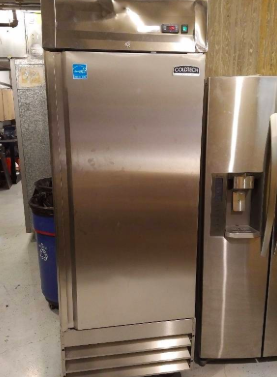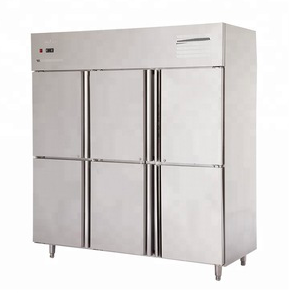If there’s a single piece of equipment that forms the backbone of any commercial kitchen, it’s the refrigeration. After all, before you throw anything on the flat top, stick anything under the broiler, or drop anything into the spattering deep fryer, you’ve got to establish a system for keeping all of your inventory fresh, clean, and safe, to prevent food waste, spoilage, and pathogens.
Browse active listings for our used refrigerators below. We are able to offer some of the lowest prices online on pre-owned equipment so you save money.
[display_listings l_type=”85″]
Commercial kitchen refrigeration comes in all shapes and sizes, from full-sized walk-in coolers, to sandwich prep units, to the dinky fridge you bought from the scratch-and-dent section of your local home improvement warehouse store. We’ll be talking about each of these options in other posts, but for now, let’s focus on the workhorse of the commercial kitchen: The standing reach-in refrigerator.
Boasting single or twin doors and usually without an integrated freezer, you’ll be in and out of your reach-in refrigerator sometimes hundreds of times per day. Finding a unit that’s easy to clean, doesn’t take up too much space, and most importantly, maintains a consistent internal temperature is key.
How Do You Use Commercial Refrigerators?

Though every kitchen is set up differently, here’s a pretty common scenario: The walk-in refrigerator may contain unprepared ingredients, such as fresh produce, bulk items, and raw meat. There may be a few smaller “prep” refrigerators scattered around the space, to use for finishing plates. And in the middle of everything sits the large reach-in fridge, which may contain finished elements of dishes, like cooked chicken or pork, backup containers of finished sauces or side dishes, or “work-in-progress” items that are either being saved for another service, or waiting to be finished later (think marinating meats, prepped and chopped vegetables, or anything that’s next in line to be used, including back-up containers of prepped food waiting to be swapped into the sandwich or prep units).
As much as is feasible, plan your trips to the reach-in refrigerator ahead of time to prevent needless, energy-wasting door opens-and-closes, which can help prevent unnecessary wear and tear on your hard-working compressor. Remember also that where you place the unit in your kitchen can impact its performance; if the refrigerator is placed in the hottest part of your kitchen, it will have to work even harder to keep a consistent temperature, and may be affected more by frequent door opening and closing.
How to Evaluate a Used Commercial Refrigerator

Because of their central role in a commercial kitchen, stand up reach-in fridges tend to get used pretty hard. Fortunately, they’re designed to withstand a fair amount of abuse. When evaluating a used commercial refrigerator for potential purchase, the most important thing to check is whether the unit is maintaining a consistent temperature of less than 40 degrees.
Check for tight seals around all edges of the doors, and look for dents or dings that may not affect the function of the unit, but can help you evaluate overall how well (or badly!) it was treated. Make sure lights (if applicable) work, and make sure that the power supply for the refrigerator matches the type of installation required for your location.
Check for buildup of grease, dust or grime in the air vents, and listen closely to the sound of the compressor; any clanging or unusual sounds (these will be hard to miss; picture what a fork in a blender would sound like) could indicate an issue with the fan or fan housing, which could spell trouble in the future. Check for ice buildup on the coils inside the refrigerator, which may indicate a problem with the unit’s thermostat, compressor, or defrost cycles.
Be wary of commercial refrigeration units with prices which seem too good to be true; we’ve seen plenty of refrigerators for sale that are cosmetically perfect and with a low sticker price, with only a quick mention at the end of the description that the compressor doesn’t work.
While this may seem like an inexpensive way to purchase an otherwise very costly piece of equipment, be aware that purchasing a new compressor for your refrigerator can cost hundreds (or even thousands) of dollars.
Purchase a commercial refrigerator that matches your intended use. For example, if you plan to store whole cases of produce inside your new fridge, you’ll want a unit with as much physical depth as possible. If you’re planning to store smaller containers of prepped sauces or condiments, you’ll want a unit with as many internal shelf configuration options as possible. And if you’re looking for a unit to store uncooked meat or fish, you’ll want a unit capable of maintaining a lower temperature, to help keep food fresher, longer.
Consider how much refrigerator you really need, for what you’re willing to spend; while “bigger is better” may seem like the norm for refrigeration unit purchases, since more space will allow you to grow, remember that it costs money to keep an enormous, half-empty refrigerator running.
While it’s always nice to buy an inspection-ready, sparkling clean unit, don’t be distracted by mold, grime, or mysterious spilled, sticky messes. Everything on a commercial refrigerator can be cleaned, and we’ve seen some truly disgusting pieces of equipment restored to a sparkling shine. If the unit is particularly dirty, try using that as a negotiating point for a better price.
How to Use a Commercial Refrigerator

First, determine the ideal placement for your refrigerator; remember that you will be accessing the unit multiple times per day, and depending on the size of your kitchen, that could mean a lot of needless running back and forth. While a stand-up reach-in fridge doesn’t need to necessarily be right in the middle of the action, it shouldn’t be too far away. Consider which way the doors swing open and closed, proximity to other pieces of equipment, and where you may need to reroute electrical to accommodate the unit.
Many modern, higher-end commercial refrigerators include a digital temperature readout, but if not, hang an inexpensive thermometer inside to ensure your new commercial refrigerator is maintaining a consistent temperature, to prevent food safety issues, spoilage, and waste.
Establish a relationship with a repair person that specializes in commercial refrigeration equipment, because sooner or later, every refrigerator has problems that you’re probably not equipped to deal with. Even though as restaurant owners and chefs, we’re also pretty handy with appliance repairs, everyone encounters a refrigeration problem that is beyond their level of expertise, sooner or later.
Look for a service person that provides emergency service, on weekends or in the middle of the night, and who can work on your commercial refrigeration on-site, without the need to haul the whole unit into the shop for repairs. As you use your refrigerator, keep an eye on the temperature readout, and listen for compressors that don’t seem to kick on as often as they used to, or which suddenly may be making new, strange noises.
It’s probably also a good idea to have a plan for what you will do if you walk into your restaurant in the morning to find a refrigerator that’s stopped working; learn which foods you’ll have to discard, and which can be moved to a secondary refrigerator while the broken one is repaired.
Finally, keep your commercial refrigerator spotlessly clean. Spills that aren’t tended to quickly can build up into a stinky, unsanitary mess that is bad for your customers, bad for your product, and will earn you negative marks or even a potential shutdown on your next health inspection. Clean the inside of the unit at least weekly with a diluted bleach solution, and invest in a stainless steel cleaner to keep the outside of the unit clean, smudge free, and looking beautiful.
